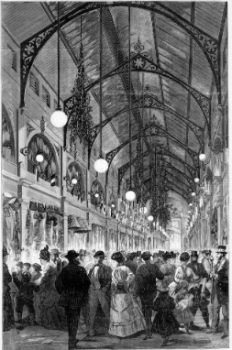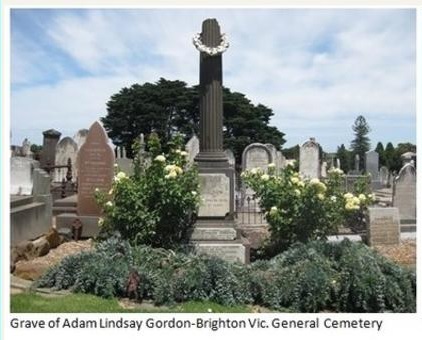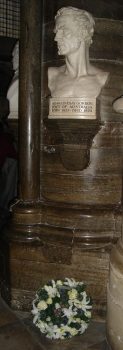Lady Hilton-Young Interviewed by Coralie Clarke Rees
The West Australian Monday 28 May 1934, page 7
LONDON. April 26. – There are remarkably interesting associations about the woman sculptor who was chosen to do the bust of Adam Lindsay Gordon. “National Poet of Australia.” which will be unveiled in Poets’ Corner, Westminster Abbey, by the Duke of York on May 11.
Lady Hilton Young, as well as being one of the most prominent English sculptors of today, was the wife of the gallant but ill-fated captain Scott who explored so much of the Antarctic and died when returning from the South Pole in 1912. She is now married to the Right Honourable Sir Edward Hilton Young, G.B.E., D.S.O., M.P., Minister of Health in the present Cabinet, and her elder son, Peter Scott, is the god-child of Sir James Barrie, and a rising young artist.
I met this stimulating woman at her home facing Kensington Gardens a few days ago and was impressed by her crisp, direct manner. She was unwilling to dwell on personal details about herself, but where her sculpture was concerned was all alertness and enthusiasm. She led me straight through a spacious drawing room, down some steps and into one of the most charming English back gardens that I have seen – all trees, shrubs, lawn, and crazy-paving, with, in the centre, a small pond. At the corners of the garden some of Lady Hilton Young’s own sculpture stood upon pedestals.
The Best Described.
Her studio is a glass-walled building at the bottom of the garden, and it was there that I was privileged to look upon the not-quite-finished bust which, in a few weeks is to be set up in the Abbey for all time. I think Australians who, in future make a pilgrimage to Poets’ Corner to honour the memory of their sportsman-poet, will be grateful to Lady Hilton Young for the strong, characterful head she has modelled. It is larger than life size, and when set at a height of seven feet from the ground, will accentuate the noble contour of Gordon’s countenance, his boldness and integrity and at the same time his brooding eyes, betokening, as Henry Kendall has written, “A shining soul with syllables of fire.”
Lady Hilton Young formed her conception of Gordon largely from reading his poems. For his outward appearance she had astonishingly little to guide her – only one old daguerreotype and a photograph of the statue of Gordon by Montford which was unveiled in Melbourne in 1932. This, Lady Hilton Young wisely observed, so that a traditional record of Gordon’s appearance might be preserved.
She is an extraordinary quick worker and she told me that this bust of Gordon was modelled in about a month after she received the commission. Naturally, as it is her first memorial to be placed in the Abbey (it is the first to be placed in Poets’ Corner since Tennyson died), she is particularly interested in and careful about this piece of work – so interested and careful that she has had two bronze heads cast, and she is going to carve another in stone and choose which one looks best in the setting.
About me in her studio were many heads of famous men sculptured by her hand – political celebrities, like Asquith, Baldwin, Lloyd George, John Simon and James Maxton, writers like Shaw and Galsworthy, and explorers like Nansen and Scott. I had noticed in her drawing room a bust of Stanley Melbourne Bruce. Lady Hilton Young told me that it is a very recent work and she would like to see it set up somewhere in Australia.
A Prolific Worker
I suppose no woman sculptor has as many memorials to her credit in different parts of the world as this energetic sculptor. In England alone she has about a dozen outdoor statues, including war memorials, and there are others in India and New Zealand. Throughout a great deal of her work I could trace the influence of Rodin, the French master-sculptor, under whom she studied in Paris.
When I asked Lady Hilton Young if she spent long and regular hours at her work she replied; “No. I’m afraid I haven’t time for that.” She has a younger son, about nine years old, whom she takes walking and swimming, then she climbs mountains and goes skating and dancing with her elder son; and she travels extensively, having visited Greece, Turkey, Egypt, New Zealand, and South Africa. “I’ve been to Australia twice,” she said, “and loved it. I shall always treasure the memory of a walking tour I did through the Blue Mountains, camping out at nights.”
In fact, she is quite an open-air woman. She likes working outside in the garden when weather permits, and for this purpose she has a movable throne which can be wheeled about. She told me that she likes larger-than-life-size work best as it gives the sculptor more scope; and, not content with the ordinary physical strain of modelling and stone-carving, Lady Hilton Young cuts her own marble. Strangely enough she has never recorded her own sons in either bronze, stone or marble.
A Painter of Bird Life
It happened that her elder son, Peter Scott, was having his second Bond-street “one man show” of paintings of wild fowl opened on the afternoon after I visited Lady Hilton Young. She kindly invited me to be present. It was quite a distinguished little gathering because the opening speech was given by Colonel John Buchan, M.P., the prominent novelist, and among the guests were Sir James Barrie, and Mrs. Stanley Baldwin and Sir Edward Hilton Young representing parliamentary circles. Colonel Buchan said that Peter Scott was following in his father’s footsteps by being an explorer in an intensive way into the abundant natural bird life of England.
Mr. Scott’s paintings of all varieties of wild bird life studied and depicted among their native surroundings on the mud flats and fens of Norfolk, betray an intimate knowledge of an interest in natural history. I heard that it was among his heroic father’s last wishes that his son, then only a baby of one year, should study natural history.
Among Peter Scott’s paintings was a charming interior of the sitting room, with its old ingle-nook fireplace, of Sir James Barrie’s home in Adelphi, the dramatist himself being seated by the fire.
Peter Pan
Mr. Scott’s life has been closely linked with associations of his god-father. Barrie’s immortal “Peter Pan” was written in the room which is now Peter Scott’s studio, and Mr Scott was named after “the boy who couldn’t grow up.” Then Peter Scott loves wild ducks, and two from the Round Pond (the haunt of Peter Pan) have come and settled of their own accord on the pond in Peter Scott’s garden. A young man with such a talent and associations is marked out for fame from his birth.
Lady Hilton Young is very proud of her son’s work. When I asked her where he was studying she replied; “Nowhere. At home here.” But when I suggested that, in that case, possibly she was guiding his study she said; “Indeed no. He teaches me. He is a great artist.”
Footnote:
See also Sir Peter Scott Founding father of the World Wild Life Fund who also created their Panda mascot.
https://www.wwf.org.uk/updates/wwf-remembers-sir-peter-scott-our-founding-father




